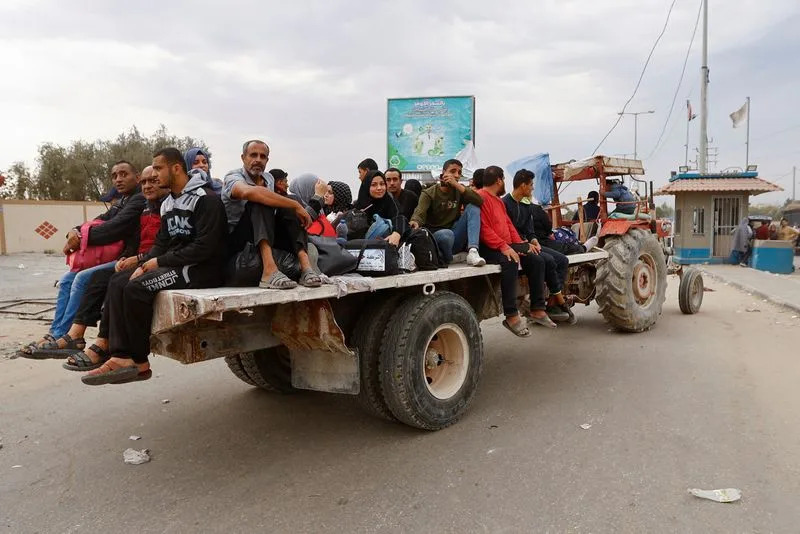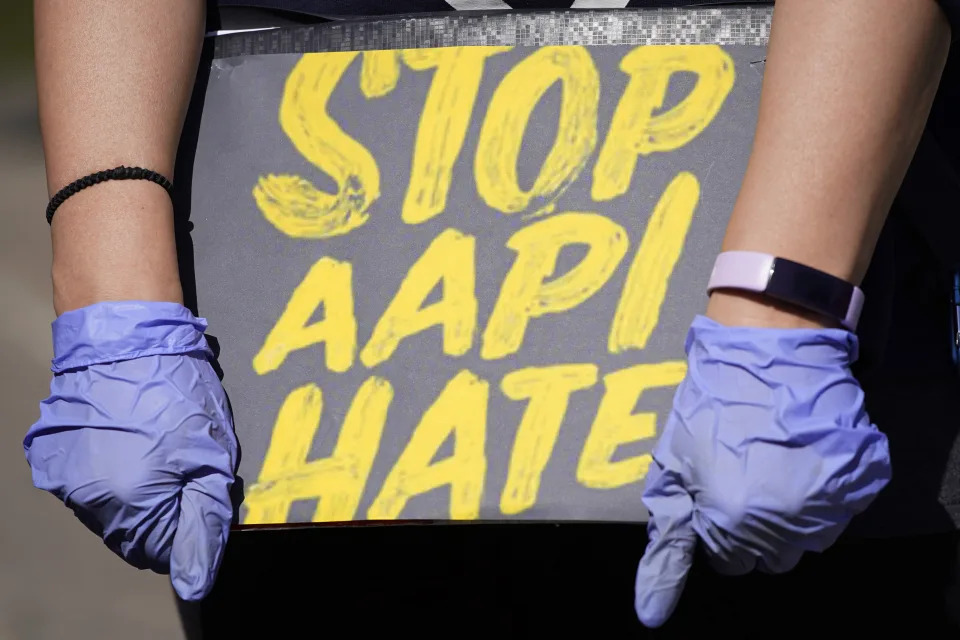Jeffrey Gettleman
Sun, November 12, 2023

Palestinian residents of the West Bank area of Huwara watch as Israeli soldiers close off the entrance to their neighborhood, on Oct. 25, 2022. (Samar Hazboun/The New York Times)
TEKOA, West Bank — As Moish Feiglin pulls up to his settlement in the Israeli-occupied West Bank, he points to an 8-foot-tall concrete slab blocking the middle of the road.
“That’s new,” he says.
He slowly drives around it and nods his head to more security barriers and heavily armed soldiers peering from behind the entrance gate. “And so is that and that and that.”
Sign up for The Morning newsletter from the New York Times
In the past month, his settlement, Tekoa, has turned into “an army base,” he says, which goes against his personal code.
“I don’t have rock-proof glass on my car windows,” he says. “I don’t want rock-proof glass.”
“But you have to understand what people are preparing for,” he adds. “They are preparing for 200 terrorists to come in.”
The West Bank, an area many times the size of the Gaza Strip and complicated in its own way, is once again a flashpoint, and all sides are clearly on edge.
While the world is increasingly critical of Israel for its bombardment of Gaza, deep concern is also rising about the actions of the Israeli military and Jewish settlers in the West Bank, a contested patchwork of Palestinian areas and Israeli settlements like Tekoa that most of the world considers illegal.
Jewish settlers of all political stripes are arming themselves, and extremists among them have attacked Palestinians and driven hundreds off their land.
At the same time, there have been more Israeli military raids, more violent protests, more arrests and more Palestinian attacks on Israelis this past month than there have been in any similar period in years.
The result is an increasingly combustible atmosphere where people are divided by faith and united by fear, and just about everyone’s humanity is being tested.
“I’m very confused inside,” says Abu Adam, a Palestinian tour guide who asked to be identified by his patronymic, afraid he could be “socially isolated” — or hurt — for expressing moderate views. “We’re suffering, they’re suffering. Everything has stopped.”
“And it’s only going to get worse,” he adds.
The story of Moish Feiglin and Abu Adam, two professionals whose lives have been upended by the violence, reveals how deeply both sides are afraid even if the power dynamic between them is vastly unequal.
As an Israeli, Feiglin can’t pry his mind away from the Oct. 7 attacks. The scale and horror in which Hamas terrorists slaughtered an estimated 1,200 people in Israel, mostly civilians, and some brutally, has led him, by his own admission, to “close off” part of his heart.
He doesn’t like carrying a Glock. But he is allowed to, and so he does. The Israeli army has been assigned to protect his community. Still, he warily scans the open hills separating his settlement from Arab areas and begins to question many of the fundamental things he once believed in.
“I’m struggling,” he says. “Six weeks ago, I was arguing for peace, I was sending my kids to an Israeli-Palestinian summer camp, I was shopping in the village at Arab stores and embracing the ideology that went with that. And now I’m like: ‘What’s next? Can we really go back to that? Was I, in the past, too naive?’”
Abu Adam used to participate in grassroots peace efforts and also wonders if his old attitude is now out of date. He embodies the day-to-day difficulties of a Palestinian living under an Israeli occupation that leaves him stateless, curtails his movements and makes it illegal for him or any other Palestinian civilian to carry a firearm. The Israeli bombing of Gaza, 60 miles away, has killed more than 11,000 people, according to the enclave’s Health Ministry, which is run by Hamas. The images he sees on television of fellow Palestinians, bleeding and dying, mourning and overwhelmed with sorrow, he says, have hardened him.
“We’ve lost everything,” he says. “And sometimes, you just want to escape. But there’s nowhere to go.”
The two men live within sight of each other, share similar thoughts, even do some of the same kind of work.
But they’ve never met and in the occupied West Bank, they inhabit different worlds.
On the morning of Oct. 7, Feiglin was praying in a synagogue in Tekoa, and Abu Adam was leading a tour in Jericho. He was guiding an American family around what may be the world’s oldest city when his phone started buzzing in his pocket.
“I looked down at my messages,” Abu Adam says. “All I saw was: Cancel, cancel, cancel, cancel.”
His upcoming clients were backing out of trips booked for this fall, and the ones with him were so terrified by the news that they insisted on leaving Jericho immediately.
When he got home that night and collapsed on the sofa, he was horrified by what he saw on television.
“It was terrible to see people killed like that,” he said. “Hamas made a mistake.”
But, he was quick to add, “too much pressure causes an explosion.”
Up the hill, Feiglin watched his community transform before his eyes. Anyone who had a gun grabbed it, and a civilian guard force instantly formed.
Tekoa is one of the 130 or so West Bank settlements, built on land Israel seized in the 1967 Arab-Israeli war. Many are like islands, plunked down in the middle of Arab areas. They are often criticized, even among many Israelis, as the biggest obstacle to peace. Roughly 500,000 Jewish settlers live in the West Bank, alongside an estimated 2.7 million Palestinians. The settlements reflect a wide range of politics and lifestyles, from ultranationalist communities to more moderate ones focused on agriculture.
A half-hour south of Jerusalem and with 4,300 residents, Tekoa is somewhere in the middle of the settler political spectrum. Known by some as “the hippie settlement” for its sizable contingent of artists and peace activists, it’s also home to right-wing supporters who advocate taking more Palestinian land.
So far there’s been little violence around here, and Feiglin calls the recent settler attacks in other areas “reprehensible,” “against Jewish values” and “very, very fringe.” And such aggression, he says, clearly contrasts with the modicum of interdependence that Tekoa and neighboring Arab villages had maintained, out of necessity more than anything else.
Before Oct. 7, scores of Palestinian men worked on construction sites in the settlement, which, with its tract housing and squiggly streets, looks like an American subdivision. Some settlers, like Feiglin, ventured into Arab areas to buy hardware or get their cars fixed.
Sometimes Jews and Arabs shared meals, played music together or gathered with their families at a campground near Bethlehem. None of this is happening now.
Feiglin is a therapist, musician and desert guide. He specializes in breath work and music therapy. But with tourists fleeing Israel, his tourism business, like Abu Adam’s, has dried up.
Both are running short on cash. Both are worried about their children. Feiglin’s 10-year-old daughter was riding to school this spring, he says, when a group of Palestinians attacked her bus with rocks. She’s still shaken by it. As for Abu Adam, he worries that his kids will be the ones throwing rocks.
It was for his children’s sake, Abu Adam says, that he had joined local peace efforts in which Palestinians met with Israelis and discussed ways to live together. As a young man, he had been jailed for participating in violent protests against the expansion of Tekoa, which he and other Palestinians said was built illegally on their land.
“But the problem I faced in my life,” he says, “I didn’t want my kids to face.”
Feiglin, 39, is a bit of a contradiction. Australian-born, he moved to the West Bank eight years ago. He says he enjoys spending time with ordinary Palestinians and promoting peace and coexistence.
But doesn’t the very existence of his settlement only complicate peace and coexistence?
“It’s a question I’ve asked myself,” he says. “My presence in the settlement won’t change facts on the ground.”
He chose to live in Tekoa, he says, for its sense of community and the intoxicating effects of living on the edge of a spectacular desert. He finds himself thinking about his Palestinian acquaintances like Ismail, a hardware store owner whom he used to see all the time and now hasn’t seen for weeks.
“All these micro-interactions,” he says, his voice trailing off during a conversation in his kitchen. “I don’t know how far this is going to rewind us.”
“But trusting would be a risk, right?” says his wife, Adena Firstman, sitting next to him. “We’re, like, in survival mode.”
Feiglin cracks an almond between his teeth and answers, “We’re in Rambo mode.”
No place may better demonstrate “Rambo mode” than a hilltop near Tekoa that Jewish settlers recently seized in clear violation of Israeli law.
Feiglin drives there along a bumpy road, past yawning canyons dotted with scrub brush and white stones. The Dead Sea shimmers in the distance. Beyond stand the red rock mountains of Jordan.
The landscape feels ancient, but the road itself is freshly bulldozed. “At any other time,” Feiglin says, “the settlers who made this wouldn’t be able to get away with it.”
The hilltop is guarded by four young men with matted hair, filthy jeans and the sidelocks of the ultra-Orthodox.
Their gear: a few radios, an ammo box, pistol clips, a prayer book, long knives and hunks of half-eaten challah. A belt-fed machine gun sits on sandbags, trained on the craggy hills.
“We should just shoot them in the head,” says Meir Kinarty, one of the young men, speaking of Palestinian protesters. “Only a bullet in their brains will make them learn.”
A reservist soldier, Andrew Silberman, who grew up in suburban Chicago, is also stationed on the hilltop. “This is totally illegal,” he says of the outpost, but he also says it’s his duty to help protect the area.
Like those of many others, Silberman’s feelings are complicated. He seems turned off by the bloodthirsty bravado of the young men strutting around with their knives. He says he understands how all the violence coursing through the West Bank, which has been rocked by major uprisings before, can radicalize people on both sides.
“But I don’t agree that hate should be the response,” he says.
When his shift ends, Silberman takes the belt-fed machine gun with him, uneasy about leaving it with the young men.
Abu Adam, from the rooftop of the home he built with his tour guide earnings, can see, with a squint, this same hilltop.
He laughs when asked what’s the way forward.
“It’s not clear,” he says. “But we have to keep looking.”
c.2023 The New York Times Company





